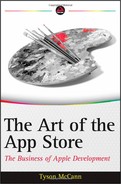CREATING FOR A MULTITASKING WORLD
Because people are drawn in a million different directions per day, more and more they're turning to their smartphone as a solution for organization as well as entertainment. Everything from calls and conferences, notifications, schedules, reports, directions, references, and, of course, leisure for those few minutes of relief can all be achieved from the smartphone or, while at work, your computer.
Paper and pen are mostly a thing of the past. Because instant communication, knowledge, and gratification have so penetrated our daily lives, people are learning to spend only moments on one thing at a time, and constantly shifting focus. This short amount of attention is likely the small window you'll have for capturing their interest and holding them there. You learn more about this opportunity later in this chapter in the section, “The Half-Second Window.” For now, let's take a glimpse into what is happening in the brain when you are multitasking, and the effects of multitasking on your ability to focus so that you can better take advantage of the small time you're allotted.
Understanding the Effects of Multitasking on the Brain
According to research published on the Proceedings of the National Academy of Sciences (PNAS) in 2009 about cognitive control in media multitaskers, participants who (after a series of questions) were pegged “heavy multitaskers” had more trouble focusing and shutting out irrelevant information, in addition to being less efficient at task-switching in general.
Many other studies have concluded the same thing. Multitasking is actually counter-productive to efficiency, and heavy multitaskers (such as those you might find using an i-device) are actually very prone to new distractions, limiting the time and focus they have for your app.
Seeing the Phone as the Ultimate Multitasking Tool
The iPhone (or any such device) is the ultimate tool for accomplishing multiple tasks in one session. It's portable, has instant notifications, can (now) efficiently multitask and switch to different programs, can accept and make calls, can chat, update and be social, can provide directions or light your way, keep lists and reminders, can keep you entertained, and has a near infinite other possible uses as well.
The take-home message from this section is that iPhone users are heavy multitaskers, and any app that requires effort to concentrate is thus likely to not be received as well. So, the need to keep the app itself simple and focused is, therefore, critically important, at least at the beginning. Some targeted niches (such as specific educational or utility apps) will, of course, need to break the rules somewhat. But for these, it's likely that your niche knows what it's getting into before even trying it out. That said, keeping it as simple as possible in the beginning will go a long way toward engaging your user.
Let's now take a look at how to best take advantage of the limited time you have for user engagement.
